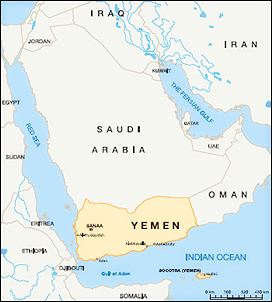|
History
Yemen’s history spans a period of 3,000 years and the country is in fact home to one of the oldest civilisation centres in the world. In ancient times the region was famed as a supply source of exotic and luxurious items such as frankincense, myrrh, spices, and condiments. Civilisations including the Minean, Sabaean and Himyarite successively ruled the country and controlled the lucrative spice trade between the 9th century BC and the 6th century AD. Marib was the capital of the Sabaean kingdom, which was ruled for a period by the legendary Queen of Sheba. Today her large temple is a major historical tourist attraction. The Sabaean civilisation endured for 14 centuries and was centred on agriculture and the spice trade. The impressive Marib Dam structure constructed in the 8th century provided irrigation for agricultural crops and is still standing today around 12 centuries later.

The Ancient Civilisation of Marib
The Romans who invaded the country in the 1st century BC referred to the country as 'Arabia Felix,' or, 'Happy Arabia', as its mountains and fertile lands distinguished it from the barren desert of the rest of the Arabian Peninsula. With the advent of the 7th century and following a period of Persian rule, Islam was introduced to Yemen and the country was ruled by a succession of Islamic rulers or Imams until in the 16th century when Yemen became partially under the Ottoman occupation. In 1839, the Southern and Eastern areas of the country fell under British influence following the capture of the port of Aden that year. Aden remained a British colonial capital for most of the 19th century with Sultans appointed to control the southern areas until the British withdrew in 1967. In 1970, South Yemen adopted a socialist regime and was renamed the People’s Democratic Republic of Yemen. In the north, the Turkish forces of the Ottoman Empire withdrew in 1918. The Imamates ruled the North until the revolution in 1962 creating the Yemen Arab Republic. Tensions remained high between the North and South until 1988 when unification discussions commenced and on 22 May 1990 the two parts formally united to form the Republic of Yemen.
Geography

Location of Yemen
Yemen is strategically located on the Bab Al Mandeb strait and has been a central shipping hub for nearly 3,000 years connecting the Red Sea, the Gulf of Aden, and the Indian Ocean. Yemen is 527,970 square km in size, which is approximately the same size as France. The country has 2,000 km of coastline stretching along the Arabian and Red Sea. It is bordered by Saudi Arabia to the north and Oman to the East, with Eritrea, Somalia and Djibouti only a short distance across the Red Sea.
The highest point in Yemen is Annabi Shu'ayb Mountain, which stands at a height of 3,760 meters (12,336 ft). Al-Rub ’al Khali desert, in the East, is referred to as the Empty Quarter due to its lack of rainfall as a result of the lower altitude (generally less than 1,000 m). Yemen has three major climatic zones; namely: desert, mountain and coastal regions. The mountains enjoy a mild pleasant climate all year round with temperatures generally in the range of 25 - 30°C during summer months, dropping to 5 - 10°C in the winter. Twice per year during the months of March and April and then again in August and September the mountains experience monsoons. Both the southern coastal regions and deserts become very hot and humid in the summer months, but are more hospitable during other times of the year.
Yemen can be divided geographically into four main regions: the coastal plains in the west and the south, the western highlands, the eastern highlands, and the Empty Quarter (Al-Rub ’al Khali) in the east. The majority of the population resides either in the mountains or along the coast, while the desert regions are sparsely populated
|